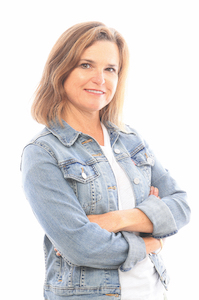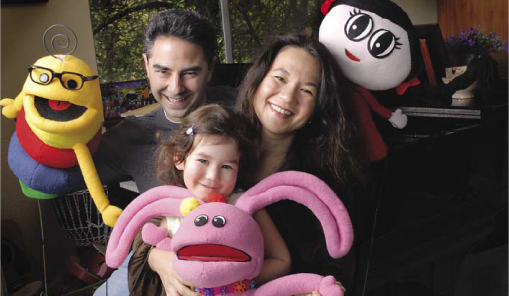Exposing children to music is not only good entertainment; it can also be beneficial to their developing minds. The online edition of the journal Brain recently reported on a study finding that “after a year of musical training, children performed better in a memory test that is correlated with skills such as literacy, verbal memory, visiospatial processing, mathematics and IQ.”
Adam Adelman and Belinda Takahashi, a pair of New Yorkers transplanted to Fairfax, have created a company that takes those studies to heart. Juno Baby provides kids with music-flavored brain food—a musical DVD series about an inquisitive tot and her kooky friends who experience life to the accompaniment of a live chamber orchestra. The company also produces original music CDs, trendy apparel, and plush dolls. Takahashi, an accomplished composer, writes all the music.
In just three years, Juno and her pals have attracted a nationwide fan base of music lovers young and old, along with a bevy of honors such as the 2006 Parent’s Choice Award and the iParenting Media award. Here is a visit with her creators.
Why the name Juno Baby? We wanted Juno, our main character, to have an empowered yet simple female name. The Roman goddess Juno is the Greek equivalent to Hera (wife of Zeus). Juno is the most important and powerful goddess and is considered the protector of all women. And Juno also happens to be the name of our daughter.
Juno Baby has been compared to Sesame Street. Those are big shoes to fill. We’ve been hearing this from our customers and are flattered to be compared to the quality, tradition and reputation of Sesame Street. A lot of our content was based on a research study, published in American Behavioral Scientist, which suggested that programs where “characters speak directly to the child, actively elicit participation, label objects and provide opportunities to respond” were “positively related to expressive language production and vocabulary.”
To ensure that our content was as strong as possible, we hired one of the researchers from this study as a script consultant for our Juno Baby series. This is where we feel Juno Baby is different. Although Sesame Street and a few others are trying to involve the viewer more, most programming for children is a passive experience. In contrast, we invite viewers into Juno’s world and have them interact with the characters on the screen.
Baby Einstein…the Wiggles…with so many toddler videos out there, is there room for another music series? We feel we have something unique to express through our characters, quality and music. Baby Einstein uses synthesized classical music, while the Wiggles play “kiddie rock.” In contrast, all the music of Juno Baby was composed for and performed by live orchestral musicians. The music is quite sophisticated yet fun, because children enjoy and can relate to the quirky character voices and story lines of the songs. In addition, we feel that our interactive content, bonus educational features, and language options (available in English, French, or Spanish) further differentiate us.
Why are most kid-oriented albums created from electronic versions of classical music? Because it’s cheap. Classical music is in the public domain so it’s free to use. Instead of hiring live musicians or paying to license good instrumental recordings, many companies choose to make synthesized versions of classical music because it’s quick and inexpensive—no actual musicians are required.
Why is it better for kids to hear music from actual instruments? An infant’s ear is entirely capable of hearing and appreciating the full textures, dynamics and colors of a symphony orchestra. Research has shown that babies prefer more complex sounds such as speech and music to simple tonal sounds and that an exposure to such complex sound patterns actually helps to develop parts of their growing brains. That being said, a simple electronic melody (even if it is by Mozart) does not represent the music as it was intended. To reduce the greatness and worth of a musical score to an electronic melody minimizes the complexities and artistry of the piece. It is impossible for a plastic electronic toy to replicate the nuances of a bow drawn across the strings of a violin. There are subtle elements in a performance that are connected to the musician’s perspective and emotion. In our opinion, children are capable of appreciating so much more than what’s offered to them.
How did you select your Juno Baby cast of characters? We wanted to create a colorful group of characters that children could easily relate to and have fun with. Each puppet has its own distinctive personality and style, strengths and shortcomings. Although the characters are so different from one another, they find a deep friendship with each other and have music as their common interest. There’s Juno, a perky pigtailed girl; Indie, a whiny cat; Bunny, a brassy rabbit; Murphy, an intellectual caterpillar; and Buzz, a mischievous bee.
Tell us more about Belinda Takahashi’s background. Belinda’s life has been completely immersed in music. She was concertizing on the piano by age eight and at ten was engaged in formal composition study. She has studied with some giants in the classical music world, from Pulitzer Prize winners to soloists from the Metropolitan Opera to renowned concert pianists. She attended Oberlin Conservatory as a composition major and received her bachelor’s degree there; she received her M.M. and Ph.D. degrees at the top-ranked music school in the country, the Eastman School of Music. Her award-winning compositions have been performed from coast to coast with performances at Carnegie Recital Hall. She has been commissioned by many artists and organizations, including the Institute for American Music, Meet the Composer, and the New Jersey Music Teachers National Association, and was chosen as the 2002 MTNA Composer of the Year for the state of New Jersey.
How did you choose Marin and Fairfax? After years of living in New York City we were craving a dramatic change in our lives. We wanted it all— a place with natural beauty, interesting and intelligent people, good weather and a large progressive city nearby. Marin definitely fit the bill. There is something so funky and charming about Fairfax. It has a small-town feel but a diverse and interesting mix of people. We also love living in the mountains right next door to West Marin while also being so close to San Francisco. Then of course there’s Scoop ice cream.
Where do you like to go in Fairfax to listen to music? We have been so struck by the talent and eclectic mix of music that exists in Fairfax. We have enjoyed listening to great jazz at BookBeat and dancing to some amazing bands at 19 Broadway. We have also had fun catching open mike night there to see the interesting variety of performers in Marin.
What are you going to do when your daughter wants to listen to music such as Barbie Hit Mix 2? Do you see any cultural value in letting her partake in pop music? Actually, she’s more of an ’80s girl. We’ve done our best to expose her to Gwen Stefani, but for some reason, she seems to be favoring bands like Toto (her favorite song at the moment is “Rosanna”). Pop music is out there and we definitely enjoy listening to some of it ourselves, so we’re absolutely fine with it if that’s what she wants to listen to.
However, we hope that’s not all she wants to listen to. It’s important for us to provide her with as many wonderful options as possible so that she’s exposed to different types of music from all countries, cultures, and time periods. We feel that exposing children to a diverse array of music promotes an appreciation of and respect for people and things other than themselves or what immediately surrounds them, thus helping them develop an interest in and sense of empathy toward others, as well as the potential to fall in love with some new and wonderful music. But of course, coming from a classical music background, we would especially love for our daughter to know and fall in love with music from the classical tradition.
To learn more about Juno Baby products and dvds, go to junobaby.com

Mimi Towle has been the editor of Marin Magazine for over a decade. She lived with her family in Sycamore Park and Strawberry and thoroughly enjoyed raising two daughters in the mayhem of Marin’s youth sports; soccer, swim, volleyball, ballet, hip hop, gymnastics and many many hours spent at Miwok Stables. Her community involvements include volunteering at her daughter’s schools, coaching soccer and volleyball (glorified snack mom), being on the board of both Richardson Bay Audubon Center. Currently residing on a floating home in Sausalito, she enjoys all water activity, including learning how to steer a 6-person canoe for the Tamalpais Outrigger Canoe Club. Born and raised in Hawaii, her fondness for the islands has on occasion made its way into the pages of the magazine.


